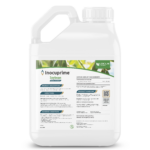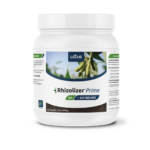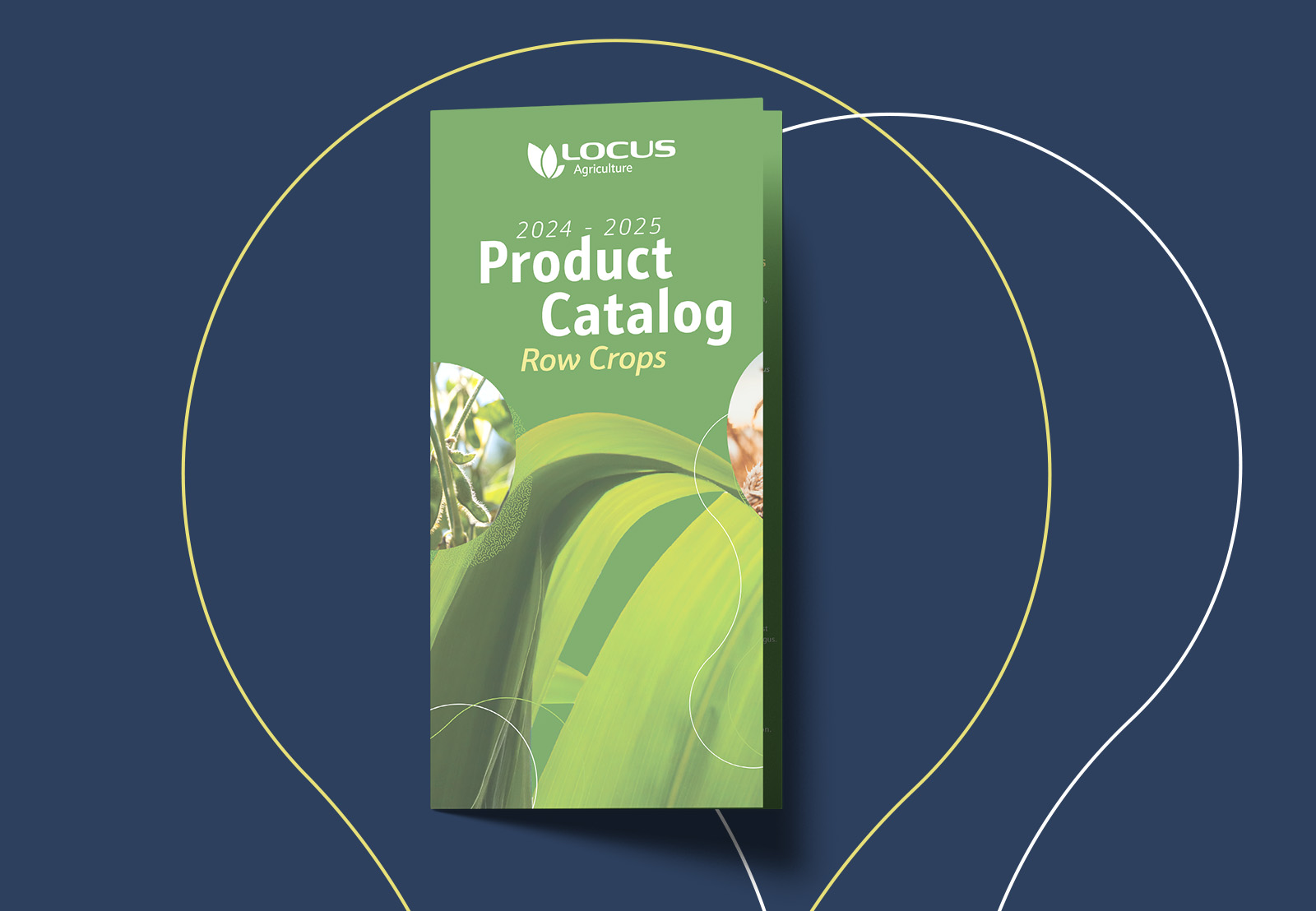
Soybean Double Inoculation: 8 Reasons When and Why to Use It
To Inoculate or Not to Inoculate Soybeans? That is the Question.
An agronomist pondering whether to double inoculate could find wisdom in Shakespeare’s Hamlet. To inoculate or not to inoculate? In the world of soybean production, this question isn’t just philosophical—it’s practical.
When Hamlet says, “to be, or not to be, that is the question,” he is contemplating whether it is better to live (“to be”) or die (“not to be”). When planting soybeans, a most valued practice is to apply a living bacteria called Bradyrhizobia japonicum. As trusted ag advisors, we must decide to give recommendations to use a single or double rate of inoculation. We must determine if these tiny organisms are “to be or not to be” once they are introduced into the harsh soil environment.
Farmers may say, “What harsh soil environment? My plants grow every year when I plant seeds into this field!” The reality is a seed can push through most of the negative extremes that are out in the fields; but a little microorganism such as Bradyrhizobia japonicum is very susceptible to difficult soil conditions.
The answer to single inoculate or double inoculate depends on soil conditions, past cropping history and environmental factors. When the right circumstances align, double inoculation can be a game-changer for maximizing nitrogen fixation and boosting yields.
What is Bradyrhizobia japonicum?
Bradyrhizobia japonicum is a specific microbial strain of nitrogen-fixing bacteria that plays a crucial role in soybean production. This tiny microorganism was first introduced to farms across the United States in 1957 and has since become essential for maximizing soybean yields.
Unlike free-living soil bacteria, Bradyrhizobia japonicum forms a symbiotic relationship with soybean roots, colonizing them and initiating the development of specialized structures called root nodules. Inside these nodules, the bacteria convert atmospheric nitrogen (N₂) into a plant-available form, ammonia (NH₃), through a process known as biological nitrogen fixation. This natural conversion provides soybeans with a significant portion of their nitrogen needs.
Without sufficient nodulation, soybeans may become nitrogen-deficient, leading to stunted growth, lower chlorophyll production and reduced pod formation.
How Much Nitrogen Do Soybeans Need?
To understand the effects of Bradyrhizobia japonicum on soybean production, it’s important to know the amount of nitrogen this crop requires.
According to Purdue University, a soybean crop will use 4.0 pounds of nitrogen per bushel of harvested soybeans (figure 1). This means a 60-bushel-per-acre soybean crop will need 240 pounds of nitrogen to grow and be productive. Yet no rational producer applies anywhere near that amount of synthetic nitrogen to their soybean fields.
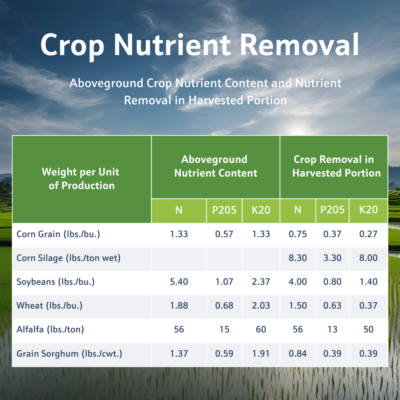
Figure 1: This chart from Purdue University explains the nutrients that are removed from the soil per bushel for different crops. Source: Purdue University, Corn and Soybean Field Guide, 2007, p. 189.
So how do we grow soybeans without applying massive amounts of synthetic nitrogen?
The air we breathe in and out every day contains 78% nitrogen, but in the N2 form. In this natural form, the nitrogen is so tightly bound together that it’s inaccessible to plants. Only lightning can break it apart.
Fortunately, soybeans have another way to access this essential nutrient. The answer comes from the microscopic organism Bradyrhizobia japonicum.
The Role of Bradyrhizobia japonicum in Soybean Nitrogen Fixation
The presence and effectiveness of Bradyrhizobia japonicum directly impacts soybean yield potential. Fields that have never grown soybeans—or those where populations of native rhizobia have declined due to soil degradation, extended crop rotations or chemical applications—often require inoculation with high-quality Bradyrhizobia japonicum to ensure optimal nitrogen fixation.
These bacteria enter the soybean root and set up shop, pulling N2 in and breaking it apart or “fixing” the nitrogen into a usable form for the soybean plant to use. Bradyrhizobia japonicum will provide most of the nitrogen the soybean crop needs, “under ideal conditions”.
The statement “under ideal conditions” is where we, as trusted ag advisors come in to determine to apply a single or double rate.
What is Double Inoculation?
Double inoculation refers to applying a double rate of inoculant to legume seeds, particularly soybeans. This ensures a robust population of nitrogen-fixing bacteria such as Bradyrhizobia japonicum. The double inoculation practice maximizes nitrogen fixation, enhancing plant productivity and ultimately boosting yields.
Standard inoculation is typically sufficient under normal conditions, but certain scenarios call for doubling the application rate to establish a strong bacterial presence and ensure effective nodulation.
When to Double Inoculate Soybeans
Several soil and environmental conditions warrant the use of a double inoculation strategy.
These last few seasons in the U.S. soybean growing areas have seen some extreme conditions, from droughts, floods, and extremely high temperatures. If any ground was exposed to these extremes in 2024, growers need to double apply Bradyrhizobia japonicum.
If a producer has too low or too high of pH in a field going to soybeans in the 2025 growing season, they need to double apply Bradyrhizobia japonicum.
If a producer is planning to grow soybeans on a piece of ground that has not grown soybeans for the last three years, they need to double apply Bradyrhizobia japonicum.
8 Key Reasons to Double Inoculate Soybeans
If any of the following eight factors apply to soybean fields, increasing the inoculant rate is essential for higher yields:
- Virgin soil that has not hosted a specific legume: Soils that have never grown soybeans or other legumes lack an established population of Bradyrhizobia japonicum. Double inoculation introduces an adequate number of bacteria to support nodulation and nitrogen fixation.
- Soil that has not hosted legumes for more than three years: Without a host crop, rhizobia populations decline over time. If soybeans or other legumes have not been planted for three or more years, double inoculation replenishes the beneficial bacterial community.
- Soil pH below 5.8 or above 8.5: Extreme pH levels reduce rhizobia survival and activity. If soil pH is outside the optimal range, correcting it is recommended. However, double inoculation can help compensate for lower bacterial viability.
- Low organic matter (<1%): Soils with less than 1% organic matter often have poor microbial diversity. Applying a double rate of inoculant ensures enough rhizobia are present to establish effective nodulation.
- Drought or flood conditions: Severe drought or excessive moisture can significantly reduce microbial populations. Double inoculation helps restore beneficial bacteria and supports nitrogen fixation under challenging conditions.
- High topsoil temperatures (>80°F): When soil temperatures exceed 80°F, rhizobia survival rates decline. A higher inoculant rate increases the likelihood of sufficient bacteria persisting to form nodules.
- Extensive soil erosion: Erosion strips away topsoil and beneficial microbes, including rhizobia. If a field has experienced significant soil loss, double inoculation helps reintroduce a healthy bacterial population.
- Use of seed treatments or chemicals that affect soil bacteria: Certain seed treatments, fungicides, and herbicides can negatively impact rhizobia viability. If chemicals known to suppress microbial activity have been used, applying a double rate of inoculant mitigates potential losses.
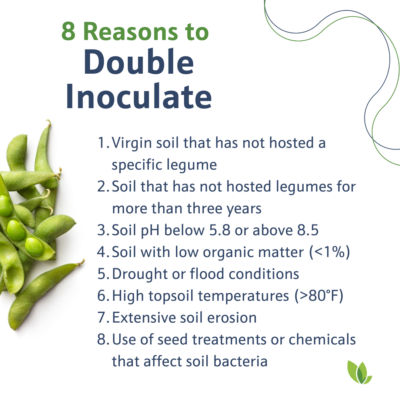
Choosing the Right Inoculant for Soybean Double Inoculation
Selecting a high-quality inoculant is key to maximizing the benefits of double inoculation. Locus Agriculture (Locus AG) offers a full suite of advanced biological products designed to perform effectively at higher application rates. The lineup includes:
Inocuprime® Soybean Liquid Inoculant: A basic liquid microbial inoculant
- Application: On-farm seed treatment
- Strain: Bradyrhizobia japonicum
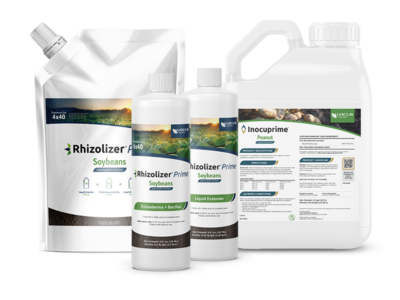 Rhizolizer® Prime Soybean Inoculant System: A premium, all-liquid inoculant
Rhizolizer® Prime Soybean Inoculant System: A premium, all-liquid inoculant
- Application: Commercial seed treatment
- Strain: Bradyrhizobia japonicum, endophytic microbial strains Trichoderma and Bacillus, and a liquid extender
Rhizolizer® Prime Box Applied for Soybeans: An advanced dry powder inoculant
- Application: planter box / hopper box
- Strains: Bradyrhizobia japonicum, Bacillus, two strains of Trichoderma and talc / graphite
These products are proven to enhance root development, nutrient uptake and overall plant resilience while improving nitrogen fixation.
Conclusion: Is Double Inoculation Right for Soybean Fields?
Evaluating soybean field conditions is crucial in determining whether double inoculation is necessary. If any of the above factors apply, doubling the inoculant rate can significantly improve nodulation, nitrogen fixation and ultimately, soybean yield potential.
Locus AG’s biologicals are designed for flexibility, ensuring effective results at both standard and double inoculation rates.
If you have questions about which biologicals products work best for your operation or unsure whether you need to double inoculate with Bradyrhizobia japonicum, contact your local Locus AG trusted advisor for expert guidance and tailored recommendations.
Download Our 2024-2025 Row Crop Biological Product Catalog
It’s not too late…Get started with Locus AG’s Simply Vital biologicals today.
Made in the USA and available immediately in box applied and liquid seed treatments. Fill out the form below and one of our agricultural experts will be in touch.



